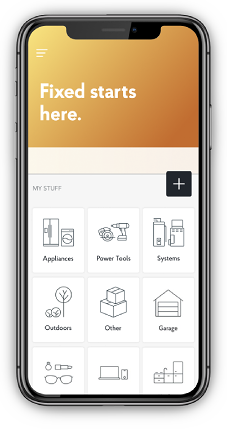Why Read This Article?
Finish Nailer Repair - Replacing the Driver Guide (Ridgid Part # 79004001022)
Article Breakdown
Finish Nailer Repair - Replacing the Driver Guide (Ridgid Part # 79004001022)
Tools & Materials
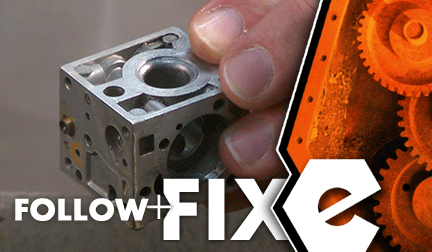

String trimmer out of whack? It's time to face the fix. Whether you are a legendary landscaper or a weekend weed whacker, eReplacementParts.com provides the parts, procedures and facts you need to fearlessly fix what fails you.
Like a steel heart within a device combining plastic, metal and wire; the carburetor fuels the vital fires that help an engine thrive. Over time, however, gaskets can deteriorate and harden. Steel arteries can constrict. Fragile valves can fail completely.
Routine maintenance goes a long way toward preventing a sudden "carb attack." But damage can be greatly accelerated when such maintenance is neglected. Fuel containing ethanol, for example, can wreak havoc on a healthy carburetor in as little as two months (if the fuel is allowed to sit in the trimmer).
Difficulty starting, rough idle, high idle, false-start, no-start, excessive fuel consumption, fuel leakage: These are the signs of a carburetor in decline. Fortunately, the carburetor repair kit contains of all of the parts you will need to rebuild, revive and reignite the steel heart of your device.
This article provides step-by-step instructions for installing a diaphragm & gasket kit on an Echo SRM-225 trimmer.
Let's get started.
 REMOVING THE CARBURETOR [top]
1. Remove the air cleaner assembly.
REMOVING THE CARBURETOR [top]
1. Remove the air cleaner assembly.
Loosen the thumb screw.
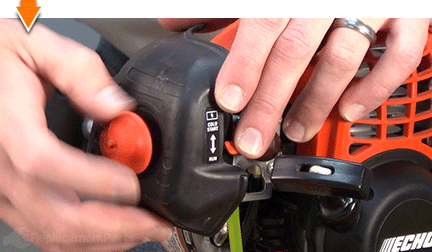
Remove the air cleaner lid.
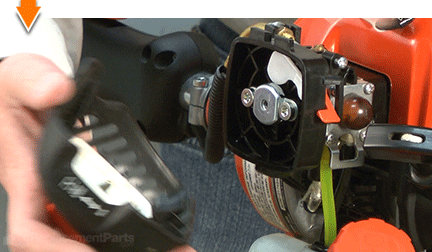
Remove the air filter.
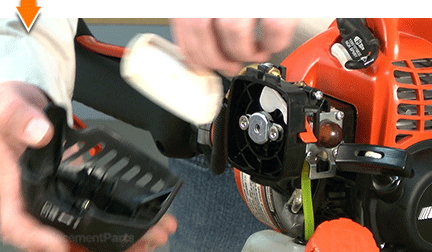
2. Drain the fuel.
Drain the fuel before servicing the unit.
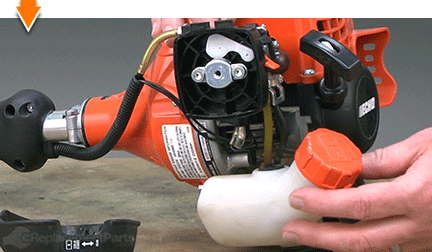
3. Remove the air cleaner case.
Loosen the (2) bracket retaining screws.
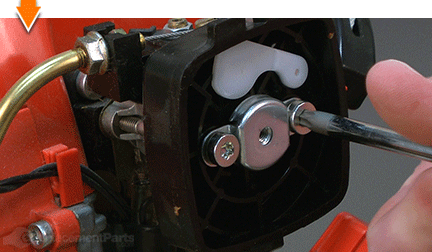
Remove the air cleaner case (along with the bracket and the screws) from the engine.
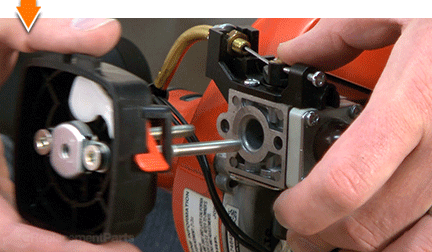
4. Remove the carburetor.
Use a wrench to loosen the throttle cable adjusting nut.
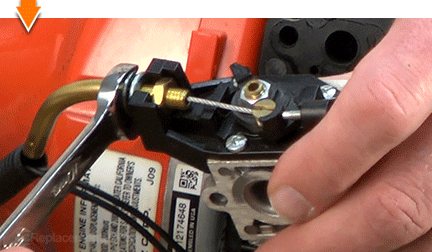
Disconnect the throttle cable from the throttle body.
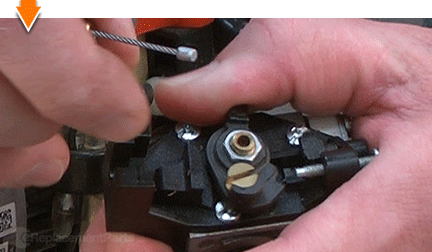
Disconnect the (2) fuel lines from the carburetor.
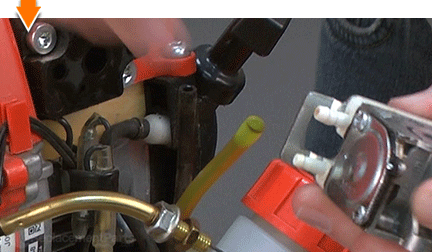
Remove the carburetor from the engine.
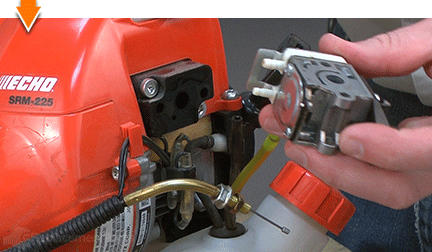
Locate and remove the intake insulator gasket. (This gasket is situated between the carburetor and the intake insulator block. Typically, the gasket will fall away from the two components as they are separated. Sometimes, the gasket will remain affixed to either the carburetor or the intake insulator block.)
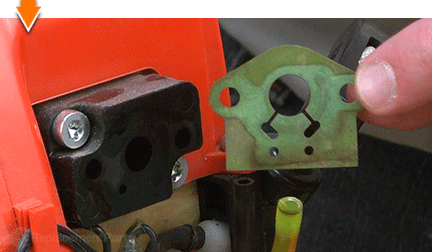
DISASSEMBLING THE CARBURETOR [top] 5. Remove the rotor cover assembly (throttle body).
Remove the (3) screws from the top of the rotor cover assembly.
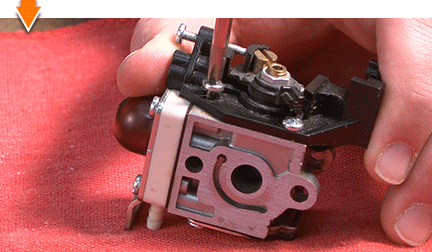
Remove the (1) screw from the side of the rotor cover assembly.
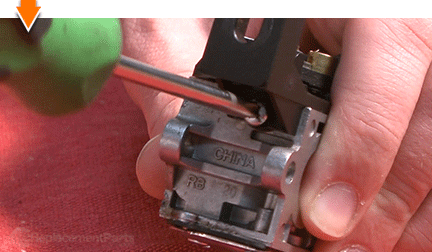
Lift the rotor cover assembly away from the carburetor.
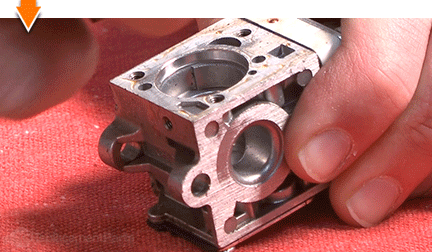
Use a pick or small screwdriver to remove the O-ring from the throttle body.
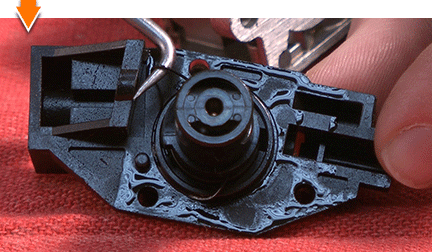
6. Remove the guide roller.
Use long-nosed pliers to remove the metal roller from the mounting post in the carburetor.
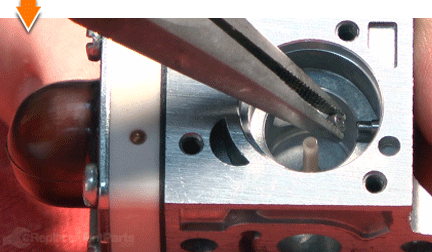
7. Remove the primer bulb.
Remove the (4) screws from the primer pump cover (plate).
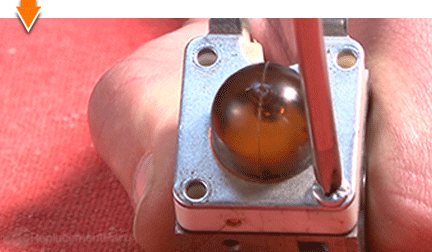
Remove the primer pump cover (plate) from the carburetor.
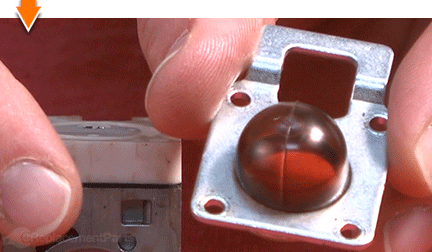
Remove the primer bulb from the carburetor.
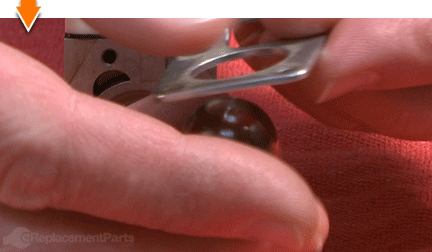
8. Remove the purge base assembly.
Remove the (1) screw from the purge base assembly.
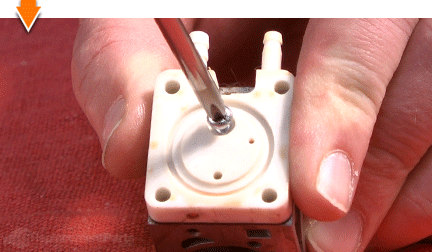
Remove the purge base assembly from the carburetor.
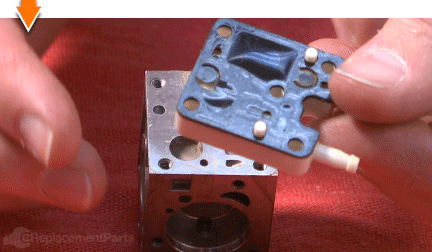
Remove the reed valve from the purge base assembly (or the carburetor).
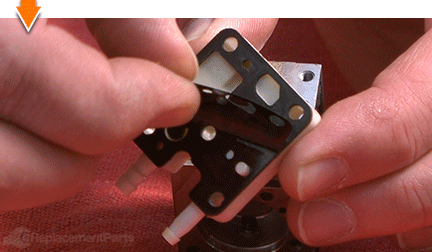
Remove the gasket from the purge base assembly (or the carburetor).
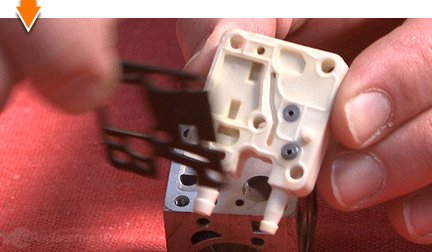
Use a pick or small screwdriver to remove the metal filter from the carburetor.
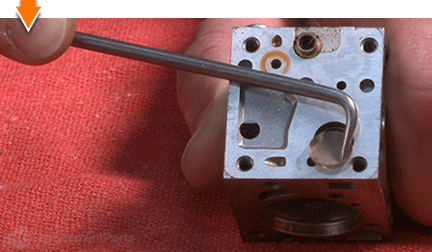
9. Remove the metering cover.
Remove the (2) screws from the metering cover.
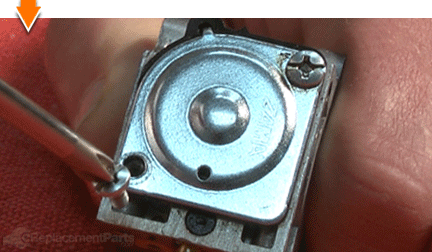
Remove the metering cover from the carburetor.
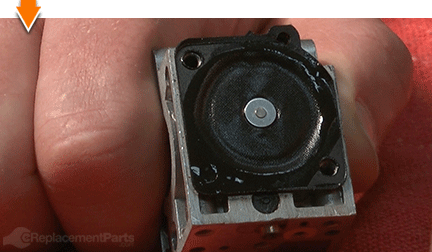
Remove the diaphragm from the carburetor.
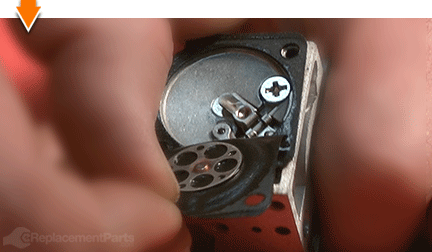
Remove the metering gasket from the carburetor.
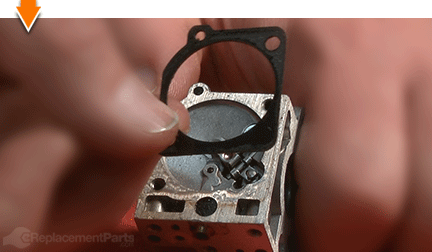
10. Remove the metering lever and needle.
The metering lever is spring-loaded; place your finger over the lever to prevent the assembly from springing out of the carburetor as you remove the screw.
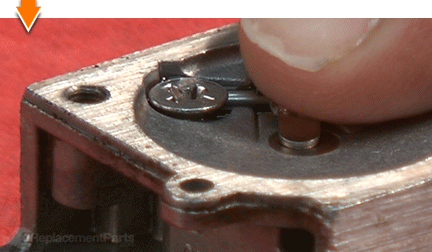
Remove the metering lever pin screw.
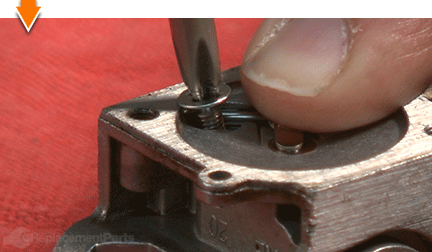
Slowly release tension from the metering lever.
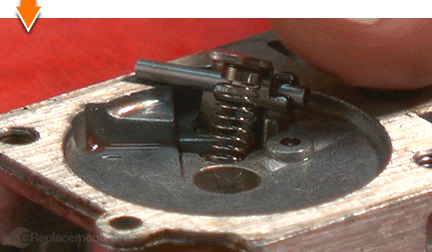
Remove the metering lever and hinge pin from the carburetor.
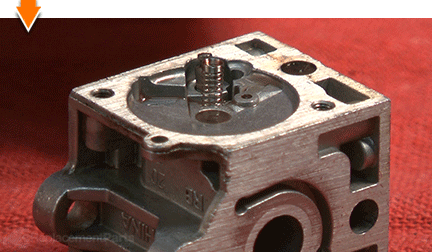
Remove the lever spring from the carburetor.
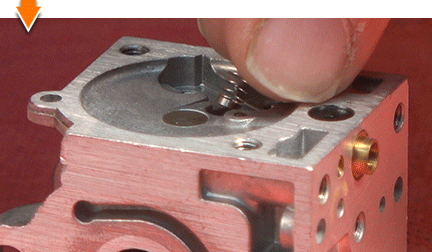
Remove the needle from the carburetor.
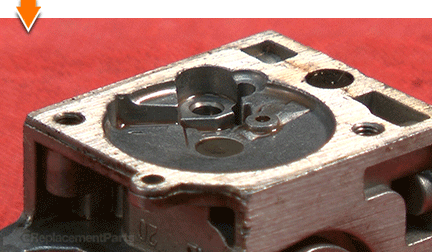
CLEANING THE CARBURETOR [top] There are two general methods for cleaning the carburetor. The traditional (chemical) method uses carburetor cleaner spray to dissolve grime, varnish and carbon residue. The alternative method requires an ultrasonic cleaner, which uses ultrasonic shockwaves (and water) to clean carburetor components. Both methods are described below.
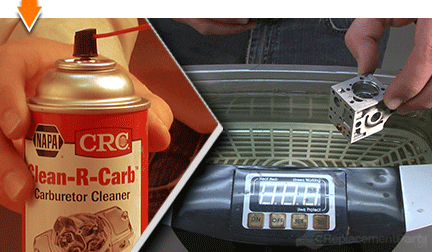
11(A). Cleaning with chemical spray.
Liberally spray/clean the metal body of the carburetor (according to the directions on your specific brand of carburetor cleaner).
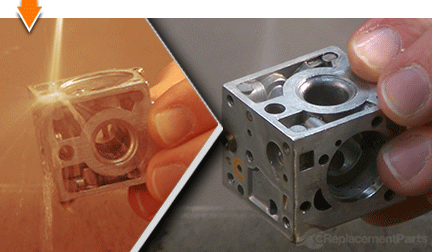
Use the long plastic nozzle to direct the spray into of each of the tiny openings on the carburetor body. However, do not actually insert the nozzle (or any metal objects) into the openings. Doing so may damage the carburetor. Fishing line may be used to safely clear/clean badly obstructed passages.
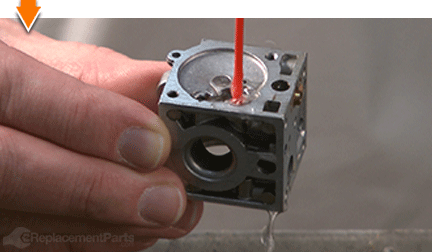
Liberally spray/clean the throttle body assembly.
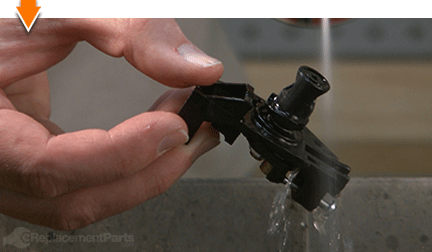
Liberally spray/clean the purge base assembly.
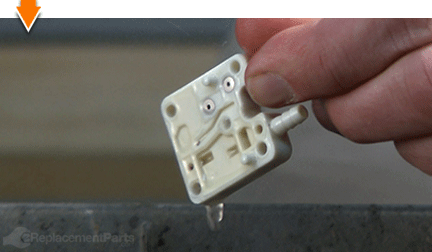
11(B). Cleaning with an ultrasonic cleaner.
Insert the carburetor, purge base assembly, and throttle body assembly into the cleaning tank.
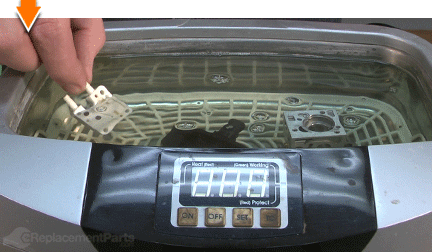
Activate the ultrasonic cleaner (according to the directions on your specific model).
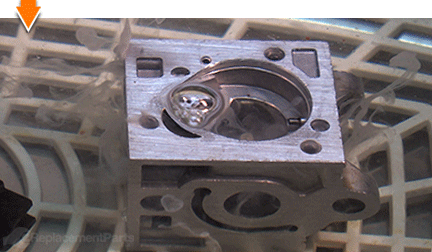
Remove the components from the cleaning tank.
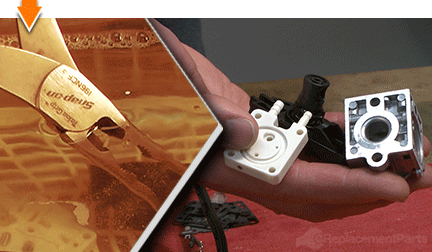
Rinse the components with clean water.
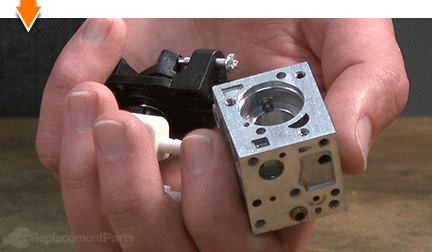
12. Remove excess water from the cleaned components.
Regardless of the cleaning method employed, use compressed air (with blower nozzle) to remove excess water (or cleaner) from the carburetor, purge base assembly, and throttle body assembly.
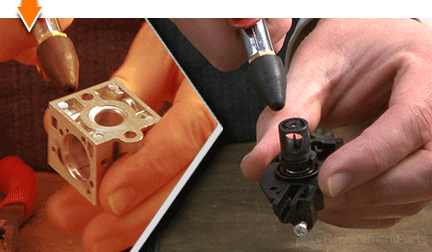
REBUILDING THE CARBURETOR [top] 13. Install the new metering lever and needle.
Install the head of the metering needle into the fork of the metering lever.
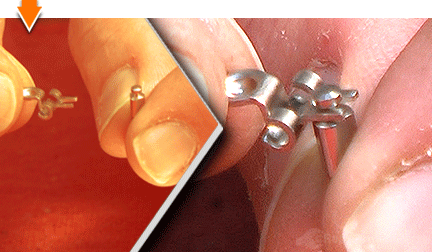
Install the lever hinge pin onto the metering lever. (The hinge pin should pass through both of the hinges on the metering lever.)
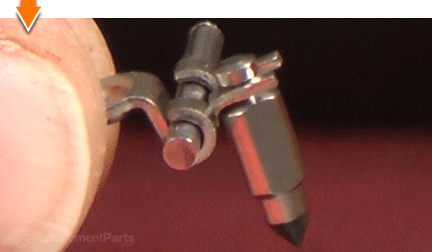
Insert the valve spring into the mounting hole on the carburetor body.
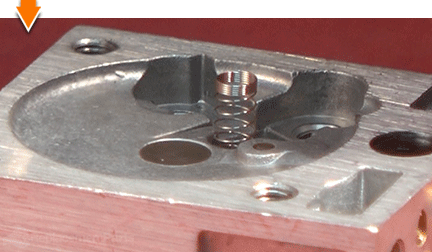
Install the metering needle and lever assembly into the carburetor body. The needle should slide into the hole. The hinge pin should seat snugly within the body of the carburetor (i.e. the pin will align itself laterally in order to fit correctly into the body).
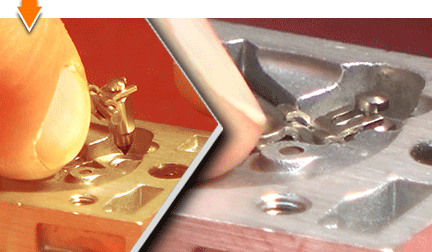
Align the metering lever above the spring.
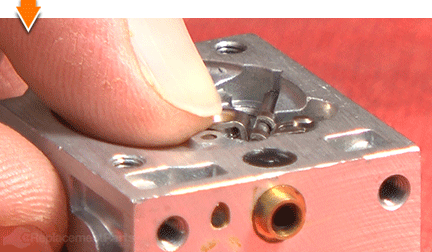
Secure the metering lever and needle assembly with the screw.
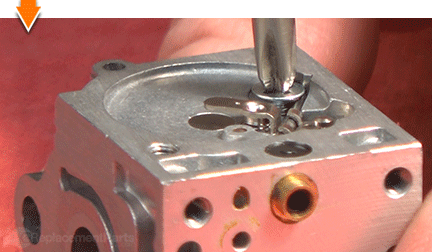
14. Install the new diaphragm and gasket. (Needle side of carburetor.)
Place the new gasket on the carburetor body and align the mounting holes.
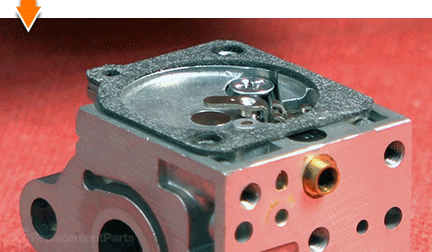
Place the new diaphragm over the gasket and align the mounting holes. The metal portion of the diaphragm should face down.
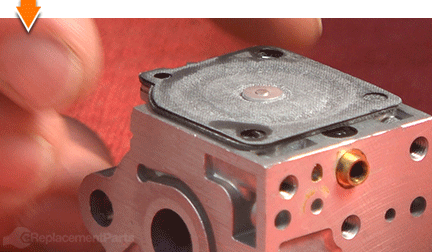
Place the metering cover over the new diaphragm and gasket.
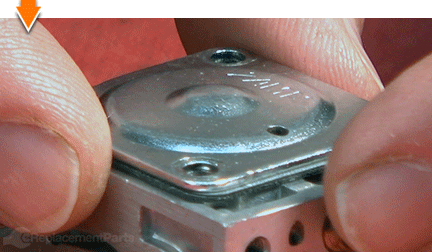
Secure the metering cover with the (2) screws.
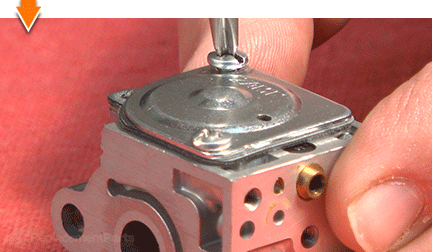
15. Install the new reed valve and gasket. (Primer side of carburetor).
Install the new filter into the recess on the carburetor body.
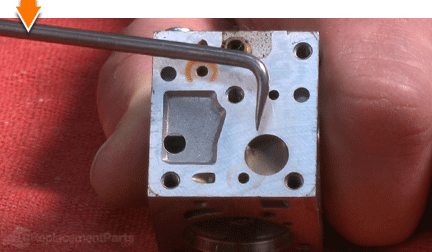
Place the new reed valve on the carburetor body and align the mounting holes.
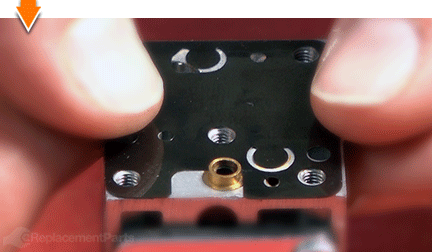
Place the new gasket over the reed valve and align the mounting holes.
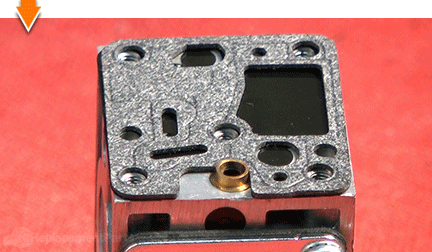
Install the purge base assembly over the gasket.
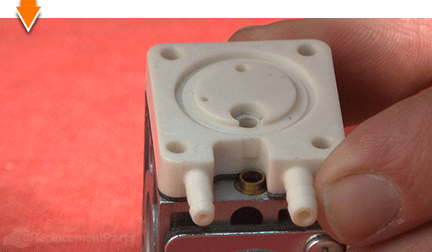
Secure the purge base assembly to the carburetor with the (1) screw.
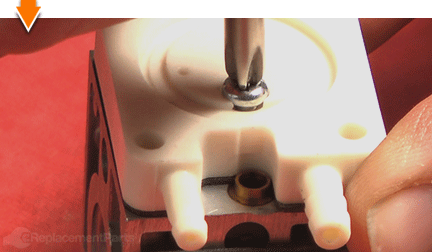
16. Install the primer bulb and cover.
Install the primer bulb onto the purge base assembly.
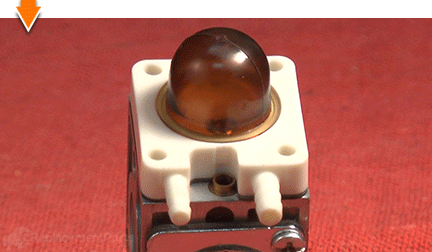
Install the primer pump cover (metal plate) onto the purge base assembly.
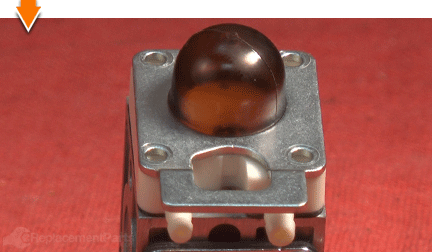
Secure the primer pump cover with the (4) screws. (Tighten these screws evenly.
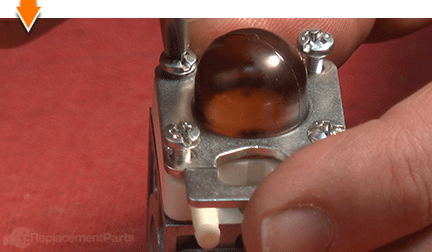
17. Install the new guide roller. (Throttle side of carburetor.)
Use long-nosed pliers to slide the new roller onto the mounting post in the carburetor.
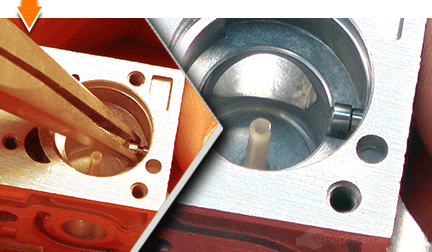
18. Install the O-Ring on the rotor cover (throttle body).
Install the O-ring onto the throttle rotor.
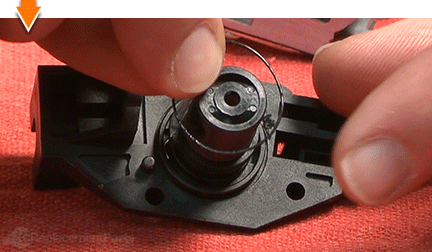
Use a small screwdriver to seat the O-ring around the rim of the throttle rotor.
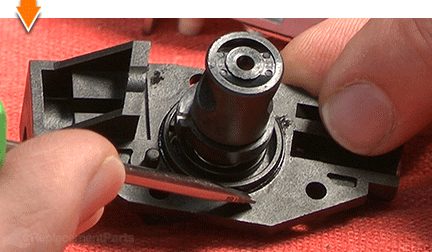
REASSEMBLING THE UNIT [top] 19. Reinstall the rotor cover assembly (throttle body).
Install the rotor cover assembly onto the carburetor.
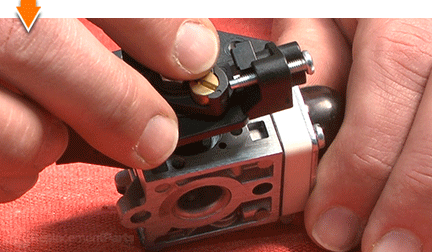
Secure the (3) screws on the top of the rotor cover assembly.
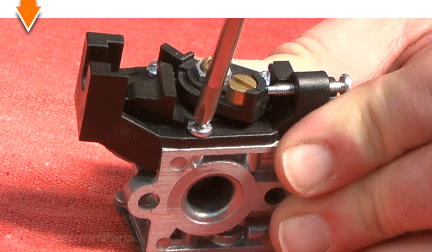
Secure the (1) screw on the side of the rotor cover assembly.
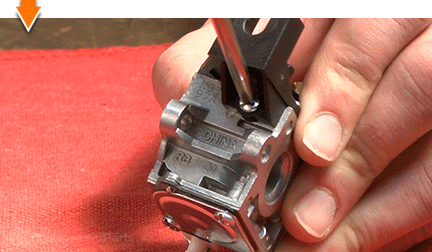
20. Connect the fuel lines to the carburetor.
Remove the gas cap and locate the fuel filter. The filter will be attached to the INCOMING fuel line. Make note of this fuel line for use in the next step.
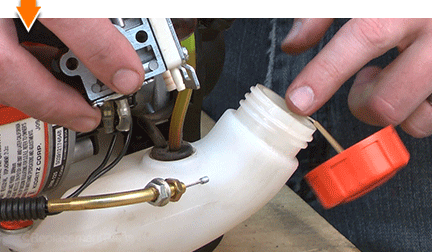
Plug either one of the carburetor ports with the tip of your finger; depress the primer bulb several times. If the primer bulb softens (deflates) without returning to its original shape; you have plugged (and identified) the incoming port.
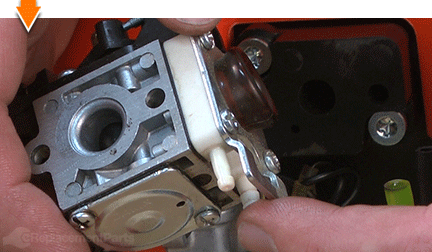
If the primer bulb fills with air (hardens) and wont allow further priming; you have plugged (and identified) the RETURN port.
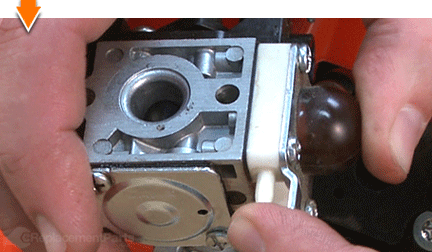
Connect the INCOMING fuel line to the INTAKE port on the carburetor.
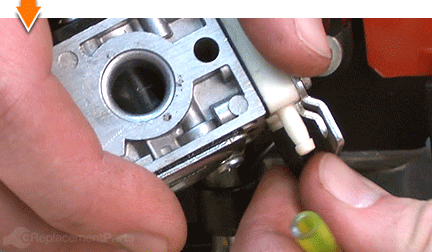
Connect the RETURN fuel line to the RETURN port on the carburetor.
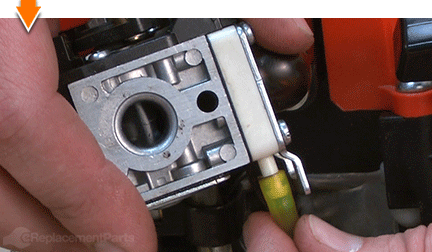
21. Reinstall the throttle cable to the carburetor.
Rotate the throttle lever on the carburetor to fully open the throttle.
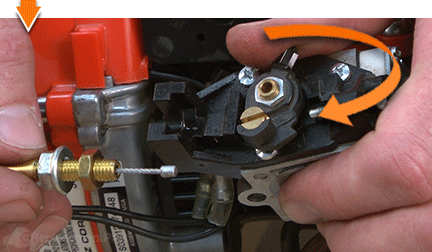
Thread the throttle cable through the brass connector on the top of the carburetor.
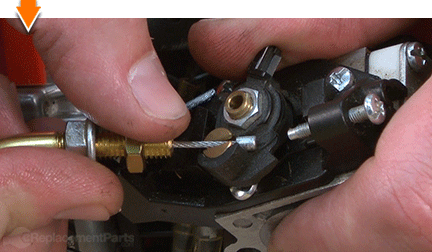
Pull back slightly on the throttle cable (away from the carburetor) to secure the tip of the cable beneath the slots of brass connector.
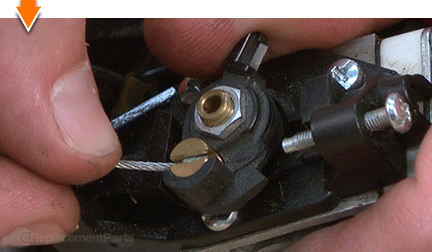
Press the throttle adjustment nut (on the cable) into the recess on the throttle body.
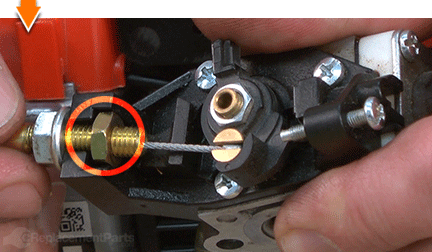
Use a wrench to secure the secondary throttle nut.
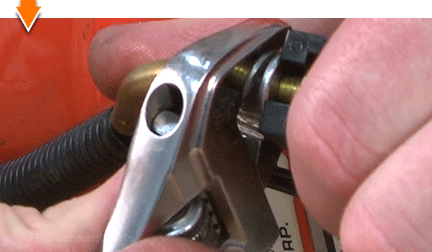
22. Reinstall the carburetor.
Thread the (2) mounting screws through the mounting holes on the air cleaner bracket and the air cleaner case. The bracket should be flush against the interior of the air cleaner case (on the same side as the choke valve).
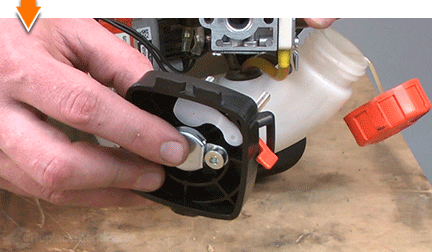
Thread the screws (protruding from the air cleaner case) through the holes on the carburetor assembly.
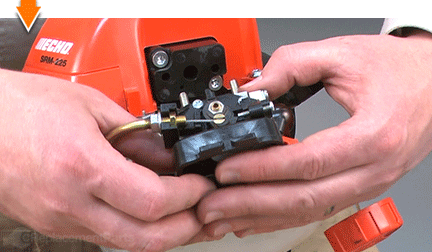
Note that there are two small holes on the intake gasket (besides the main intake opening and the two mounting holes). These small holes need to align with the small hole on the insulator block.
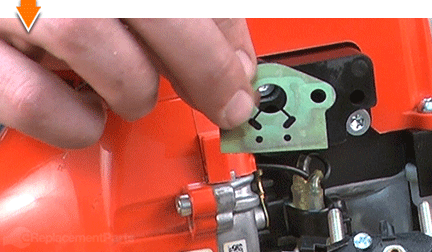
Thread the screws through the mounting holes on the intake gasket and slide the gasket flush against the carburetor.
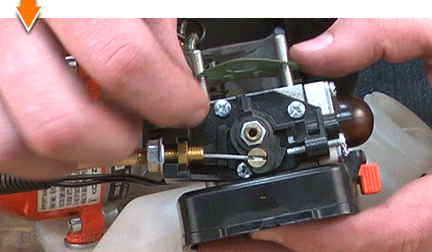
Install the intake assembly (bracket, air cleaner case, carburetor and intake gasket) onto the intake insulator block.
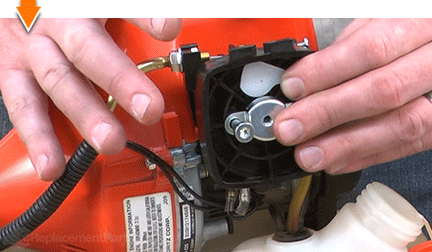
Secure the intake components (bracket, air cleaner case, carburetor and intake gasket) with the screws.
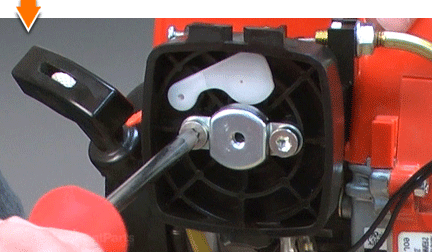
23. Reinstall the air filter.
Install the air filter into the air cleaner case.
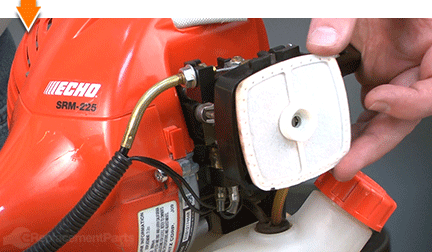
24. Reinstall the air filter lid.
Install the air filter lid onto the air cleaner case.
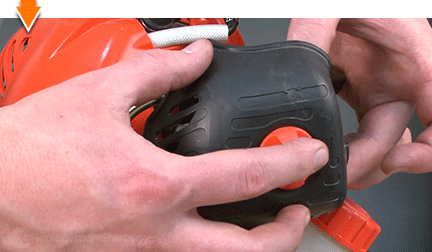
Secure the air filter lid with the thumbscrew.


You don't have to leverage your savings to level your lawns. As you just learned, repairing your own equipment is easy when you follow our step-by-step guides. Not only did you restore trimmer functionality at a fraction of the cost of replacement; you have taken the edge off of future repairs, wherever you may find them.



















































